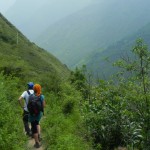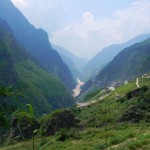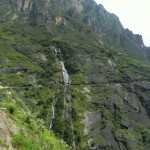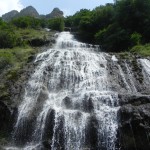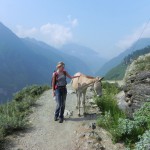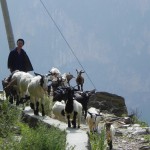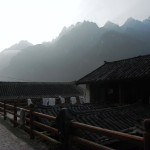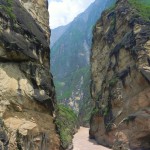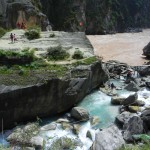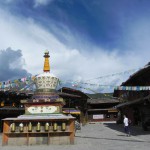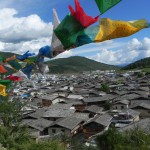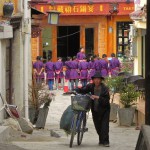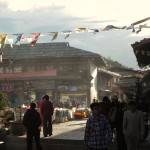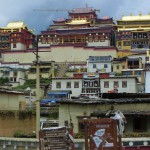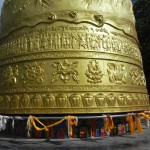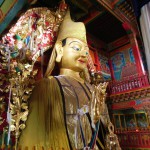 It was time to test lungs and legs – the hiking boots were calling to be used again. Trekking the magnificient “Leaping Tiger Gorge” turned out to be a great introduction into China’s wilder side. The popular gorge hike revealed the beauty of 4,000m high peaks that run vertically down into the longest river in China, the Yangtse river.
It was time to test lungs and legs – the hiking boots were calling to be used again. Trekking the magnificient “Leaping Tiger Gorge” turned out to be a great introduction into China’s wilder side. The popular gorge hike revealed the beauty of 4,000m high peaks that run vertically down into the longest river in China, the Yangtse river.
On the first day came the 28 bends, which meant a three-hour climb and a two-hour slippery descent in the rain through pine forests. Arrows helped to avoid getting lost. Our Spanish hiking partners set the pace and so we arrived at our guesthouse in record time, half way from the end of the trail. Exhausted, we enjoyed our cool beer and fried beef with rice and vegetables with a fantastic view on the Jade Dragon Snow mountains in the fading sunlight.
The second day was even more beautiful with waterfalls, criss-crossing streams, goat herds passing by. But the pain in the knees announced that the most strenous part of the hike was the last one: going first 1,000m down and then up a path leading to the rapids and the famous stone, which the legendary tiger is supposed to have used to jump to the other side of the river, thus giving the gorge its name. Having made it to the stone amidst the roaring brown Yangtse river was quite rewarding and exhilirating.
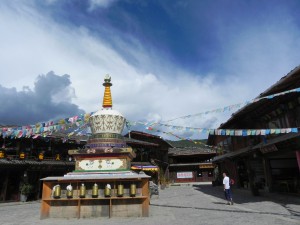 After the hike, we continued further north to a city with the famous name Shangri-la, where we started to breathe in the Tibetan air. Formerly known as Zhongdian, the city renamed itself in 2001 to attract tourists, claiming to be the fabled ‘Shangri-la’ of James Hilton’s 1933 bestseller “Lost Horizon”. Hilton’s novel tells a story of hijacked travellers who crash-land in a mountain utopia ruled by a 163-old man. Today, Shangri-la has become a synonym with paradise on Earth but especially a mythical Himalayan utopia, isolated from the outside world, and many places claihe title.
After the hike, we continued further north to a city with the famous name Shangri-la, where we started to breathe in the Tibetan air. Formerly known as Zhongdian, the city renamed itself in 2001 to attract tourists, claiming to be the fabled ‘Shangri-la’ of James Hilton’s 1933 bestseller “Lost Horizon”. Hilton’s novel tells a story of hijacked travellers who crash-land in a mountain utopia ruled by a 163-old man. Today, Shangri-la has become a synonym with paradise on Earth but especially a mythical Himalayan utopia, isolated from the outside world, and many places claihe title.
We didn’t find our Shangri-la there, but visited a 300-year-ol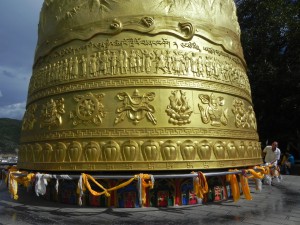 d Tibetan monastery complex near a lake, wandered around the old town with its white stupa and turned a huge golden prayer wheel three times. As there are said to be 12.4 billion “Om mani padme hum” inside, we made 37.2 billion prayers.
d Tibetan monastery complex near a lake, wandered around the old town with its white stupa and turned a huge golden prayer wheel three times. As there are said to be 12.4 billion “Om mani padme hum” inside, we made 37.2 billion prayers.
Devouring grilled yak meat and watching locals and Chinese tourists participate in a popular evening dance made the stay complete.

